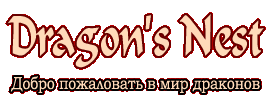
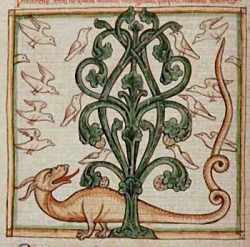 | | British Library, Harley MS 3244, Folio 58v |
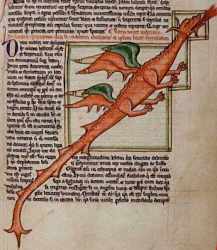 | | British Library, Harley MS 3244, Folio 59r |
 | Kongelige Bibliotek, Gl. kgl. S. 1633 4, Folio 3v
A dragon trying to hide in a hole, unable to face the roaring panther above it. Dragons cannot stand the sweet smell breathed out by the panther. This dragon is similar to the one found on folio 50r in this manuscript.
|
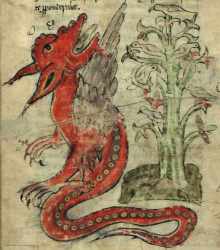 | Kongelige Bibliotek, Gl. kgl. S. 1633 4, Folio 49r
A dragon, unable to catch the doves in the peridexion tree because the tree and its shadow are harmful to dragons.
|
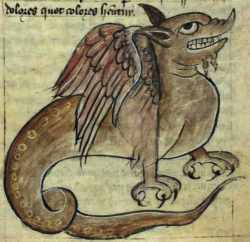 | Kongelige Bibliotek, Gl. kgl. S. 1633 4, Folio 50r
A two-legged dragon with feathered wings. It has a long tail, in which its strength lies. This dragon is similar to the one found on folio 3v in this manuscript.
|
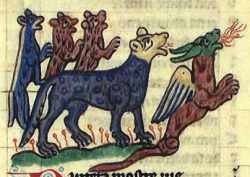 | Kongelige Bibliotek, Gl. kgl. S. 3466 8, Folio 17v
A dragon, breathing fire, fleeing from the sweet scent breathed out by the panther.
|
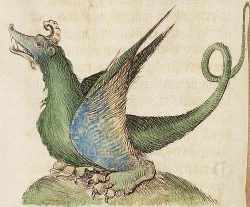 | Koninklijke Bibliotheek, KB, 72 A 23, Folio 47v
A dragon with a horn and very large feet. This image was probably the original for the copy in manuscript Koninklijke Bibliotheek, KB, 128 C 4
|
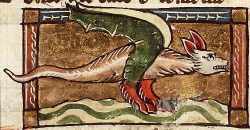 | Koninklijke Bibliotheek, KB, KA 16, Folio 104r
A colorful dragon flying over the sea.
|
 | Koninklijke Bibliotheek, KB, KA 16, Folio 124r
A red-winged dragon looking fierce.
|
 | Museum Meermanno, MMW, 10 B 25, Folio 38v
A dragon attacks a dove that has left the safety of the peridexion tree; the other dove remains protected.
|
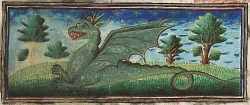 | Museum Meermanno, MMW, 10 B 25, Folio 39r
A fierce green dragon.
|
 | | Jaculus
Latin name: Jaculus
Other names: Iaculus, Javelin-snake, Javelot
A flying serpent
General Attributes
The jaculus is a serpent that can fly. It hides in a tree until an animal passes underneath, and then it throws itself down on the animal and kills it.
Sources (chronological order)
Lucan [1st century CE] (Pharsalia, book 9, verse 848): "Swift Jaculus there...". (verse 962-966): "Upon branchless trunk a serpent, named / By Libyans Jaculus, rose in coils to dart / His venom from afar. Through Paullus' brain / It rushed, nor stayed; for in the wound itself / Was death...".
Pliny the Elder [1st century CE] (Natural History, Book 8, 35): The iaculus hurls itself from the branches of a tree, so that it is not only dangerous to the feet, but flies through the air like a missle from a catapult.
Isidore of Seville [7th century CE] (Etymologies, Book 12, 4:29): The iaculus is a flying snake. They jump from trees and dart onto passing animals, from which they get their name, darter (iaculi).
|
 | Kongelige Bibliotek, Gl. kgl. S. 1633 4, Folio 55v
Salamander
Latin name: Salamandra
Other names: Silion, Stellio, Sylio
Salamanders are so cold they can extinguish any fire
General Attributes
The salamander is a cold animal. It can live unharmed in a fire, and its coldness will extinguish the hottest flames. If it enters hot water, the water will become cold.
From the salamander comes a material that is unlike any other cloth; when it becomes dirty, it must be thrown into a fire, which will consume the dirt without harming the cloth. This cloth is made in the deserts of India, and is worn by important people. This is a good description of asbestos, which some sources link with the salamander.
The salamander's poison is very strong, and can kill many at once. If it climbs an apple tree, the apples become poisonous; if it enters a well, the water becomes deadly.
Allegory/Moral
The salamander represents righteous people, who can withstand fire, just as Daniel could emerge unharmed from the fiery furnace.
|
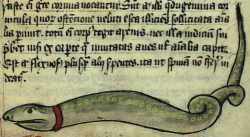 | | Scitalis
Latin name: Scitalis
Other names: Scytale
A serpent with such a marvelous appearance that it stuns the viewer
General Attributes
The scitalis is a serpent with such marvelous markings on its back that its appearance stuns the viewer, slowing the person down so that they are caught. Its heat is so great that it sheds its skin even in the winter.
Sources (chronological order)
Lucan [1st century CE] (Pharsalia, book 9, verse 841-842): "Sole of all serpents Scytale to shed / In vernal frosts his slough...".
Isidore of Seville [7th century CE] (Etymologies, Book 12, 4:19): The scitalis (scytale) has a skin that shines with such variety that by these marks it slows down any who see it. It creeps slowly and cannot pursue its prey, so it stupifies with its marvelous appearance. It is so hot that even in winter it sheds its skin.
|
 | |
 | Dragon fighting with a centaur Stone carving Westminster Abbey London, c. 1250
Francis Bond
London: Oxford University Press, 1910;
Series: Church Art in England
|
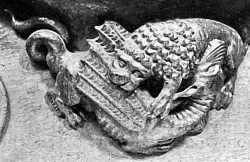 | !!!! -нет поясняющего текста
Wood Carvings in English Churches Misericords, page 23
Francis Bond
London: Oxford University Press, 1910;
Series: Church Art in England
|
 | Wood Carvings in English Churches: Misericords, page 50
Two dragons watch the drama of the unicorn and the maiden. Misericord supporters; Chester Cathedral, Chester, England;
late 14th century.
Francis Bond
London: Oxford University Press, 1910;
Series: Church Art in England
|
 | Wood Carvings in English Churches: Misericords, page 59
A dragon with four legs and bat wings. Misericord; Cartmel Priory, Cartmel, England;
late 14th century.
Francis Bond
London: Oxford University Press, 1910;
Series: Church Art in England
|
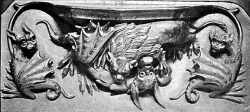 | Wood Carvings in English Churches: Misericords, page 62
A dragon fights with a lion, while two other dragons watch. This combination is unusual, though the meaning is clear: the lion is Christ, the dragon is Satan, and the lion is winning the fight. Misericord; Carlisle Cathedral, Carlisle, England;
early 15th century.
Francis Bond
London: Oxford University Press, 1910;
Series: Church Art in England
|
 | | Сосуд «Дракон». Скопинская керамика |
 | | Сосуд «Василиск». Скопинская керамика |
|

